
San Carlos is a city in San Mateo County, California, United States. The population is 28,406 per the 2010 census.
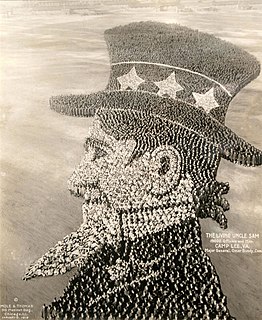
Fort Lee, in Prince George County, Virginia, United States, is a United States Army post and headquarters of the United States Army Combined Arms Support Command (CASCOM)/ Sustainment Center of Excellence (SCoE), the U.S. Army Quartermaster School, the U.S. Army Ordnance School, The U.S. Army Transportation School, the Army Logistics University (ALU), Defense Contract Management Agency (DCMA), and the U.S. Defense Commissary Agency (DeCA).
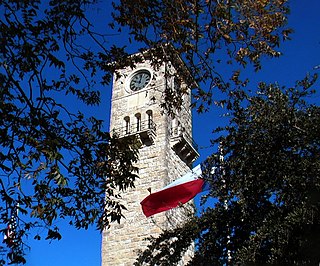
Fort Sam Houston is a U.S. Army post in San Antonio, Texas. Known colloquially as "Fort Sam", it is named for the U.S. Senator from Texas, U.S. Representative from Tennessee, Tennessee and Texas Governor, and first President of the Republic of Texas, Sam Houston.

A police dog is a dog that is specifically trained to assist police and other law-enforcement personnel. Their duties include: searching for drugs and explosives, locating missing people, finding crime scene evidence, and attacking people targeted by the police. Police dogs must remember several verbal cues and hand gestures. The most commonly used breeds are the German Shepherd, Belgian Malinois, Bloodhound, Dutch Shepherd, and the retriever breeds. Recently, the Belgian Malinois has become the dog of choice for police and military work due to their intense drive and focus. Malinois are smaller and more agile than German Shepherd Dogs, and have fewer health issues. However, a well-bred working line German Shepherd Dog is just as successful and robust as a Malinois.
Jungle warfare is a term used to cover the special techniques needed for military units to survive and fight in jungle terrain.

Fort A.P. Hill is a training and maneuver center belonging to the United States Army located near the town of Bowling Green, Virginia. The center focuses on arms training and is used by all branches of the US Armed Forces. It is named for Virginia native and Confederate Lieutenant General A. P. Hill. Fort A.P. Hill is one of ten U.S. Army installations named for former Confederate soldiers.

Established 1 July 1973, the United States Army Training and Doctrine Command (TRADOC) is a major command of the United States Army headquartered at Fort Eustis, Virginia. It is charged with overseeing training of Army forces and the development of operational doctrine. TRADOC operates 37 schools and centers at 27 different locations. TRADOC schools conduct 1,304 courses and 108 language courses. The 1,304 courses include 516,000 seats for 443,231 soldiers; 36,145 other-service personnel; 8,314 international soldiers; and 28,310 civilians.

The United States Army's Officer Candidate School (OCS) is an officer candidate school located at Fort Benning, Georgia that trains, assesses, and evaluates potential commissioned officers of the U.S. Army, U.S. Army Reserve, and Army National Guard. Officer candidates are former enlisted members, warrant officers, inter-service transfers, or civilian college graduates who enlist for the "OCS Option" after they complete Basic Combat Training (BCT). The latter are often referred to as college ops.

The Transportation Corps was established 31 July 1942 by Executive Order 9082. The Transportation Corps is a combat service support branch of the U.S. Army, and was headquartered at Fort Eustis, Virginia, but moved to Fort Lee, Virginia in 2010. It is also one of three U.S. Army logistics branches, the others being the Quartermaster Corps and the Ordnance Corps. The Transportation Corps is responsible for the movement of personnel and material by truck, rail, air, and sea. Its motto is "Spearhead of Logistics," and it is currently the second-largest branch of the Army.

The United States Army Quartermaster Corps, formerly the Quartermaster Department, is a Sustainment, formerly combat service support (CSS), branch of the United States Army. It is also one of three U.S. Army logistics branches, the others being the Transportation Corps and the Ordnance Corps.

The United States Army Quartermaster Museum, located at Fort Lee, Virginia, is an AAM accredited museum in the Commonwealth of Virginia. The museum's aim is to preserve and exhibit the history of the Quartermaster Corps, which was formed in 1775 and to date it has collected more than 24,000 items. The Museum also serves the Quartermaster Center and School as a classroom for the teaching of history, educating more than 16,000 soldiers, non-commissioned officers, warrant officers, and officers a year.
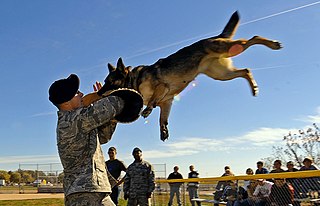
An attack dog or personal protection dog is any dog trained by a human to defend or attack persons, a territory, or property either on command, on sight, or by inferred provocation. Attack dogs have been used often throughout history and are now employed in gang, terrorist, intelligence, security, police, and military roles.
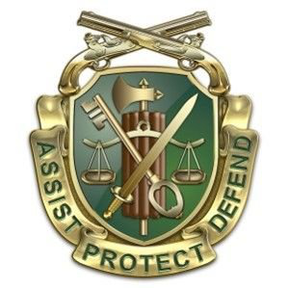
The Military Police Corps is the uniformed law enforcement branch of the United States Army. Investigations are conducted by Military Police Investigators or the United States Army Criminal Investigation Command (USACIDC), both of which report to the Provost Marshal General.

Dogs in warfare have a very long history starting in ancient times. From being trained in combat, to their use as scouts, sentries, messengers, mercy dogs and trackers, their uses have been varied and some continue to exist in modern military usage.
Chips (1940–1946) was a trained sentry dog for United States Army, and reputedly the most decorated war dog from World War II. Chips was a German Shepherd-Collie-Husky mix owned by Edward J. Wren of Pleasantville, New York.
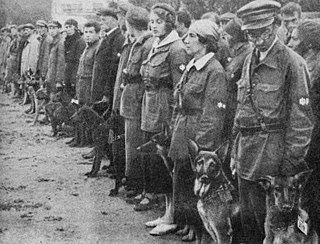
Anti-tank dogs were dogs taught to carry explosives to tanks, armored vehicles and other military targets. They were intensively trained by the Soviet and Russian military forces between 1930 and 1996, and used in 1941–1942, against German tanks in World War II. Initially dogs were trained to leave a timer-detonated bomb and retreat, but this routine was replaced by an impact-detonation procedure which killed the dog in the process. The U.S. military started training anti-tank dogs in 1943 in the same way the Russians used them, but this training exposed several problems and the program was discontinued.
The Basic Officer Leader Course (BOLC) is a two-phased training course designed to produce commissioned officers in the United States Army. Prospective officers complete Phase I as either a cadet or an officer candidate before continuing on to BOLC B as Second Lieutenants. If BOLC B is not completed within two years of commissioning, 2LTs will be administratively separated from the service unless there are extenuating circumstances. This a progressive model designed to produce US Army officers with leadership skills, small unit tactics and certain branch-specific capabilities.

The structure of the United States Army is complex, and can be interpreted in several different ways: active/reserve, operational/administrative, and branches/functional areas.

The Military Working Dog Teams National Monument is a monument to military working dogs located at Joint Base San Antonio (JBSA)-Lackland in San Antonio, Texas. The monument represents handlers, dogs, and veterinary support, from all military service branches that have made up the Military Working Dog program since World War II. The monument grounds include a 3,000 square feet granite plaza, granite pedestals, granite history wall, granite benches and water fountain. The granite pedestals have large bronze statues of dogs and handlers. The monument was dedicated on October 28, 2013.

A mercy dog was a dog that served in a paramedical role in the military, most notably during World War I. They were often sent out after large battles, where they would seek out wounded soldiers; and trench warfare suited their use. They carried first-aid supplies that could then be used by wounded soldiers and comforted dying soldiers who were mortally wounded. They were also trained to guide combat medics to soldiers who required extensive care. Many mercy dogs were trained by national Red Cross societies to serve the country in which the specific society operated. The German army called such dogs medical dogs. As many as 20,000 dogs are estimated to have served as mercy dogs in World War I and World War II, and they have been credited with saving thousands of lives. They would later go on to be used in the Korean War by the United States.


















